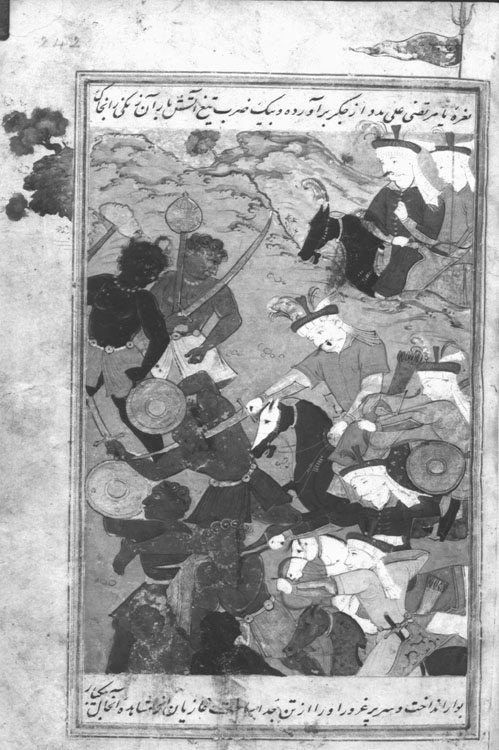The text of this manuscript relates the following story. In the Arab countries the accomplishments of Shah Esmāʿil were well known. One day, the Mamluk ruler of Egypt, Sultan Ǧānisāy Ḵādem al-Haramin, gave a celebration attended by an Ethiopian slave named Saʿadān Ǧolom-e .Ḥabashi Soltān, also known as Żujondin. This Ethiopian was well respected by the warriors of Egypt, Syria and Arabia for his ability in combat. At this festivity Żujondin began boasting and claimed he could even defeat Esmāʿil himself in combat. By coincidence, there was also present a ǧāzi from Iran, who became incensed and chastised Saʿadān for not following the proper rules of conduct. If Saʿadān felt himself a noble warrior, the ǧāzi taunted, he should challenge a person of equal station such as Khan Moḥammad Ǩān (Khan Moḥammad ʿOstājlu, the Safavid governor of Diār Bakr). Saʿadān became angered and asked Sultan Ǧānisāy for permission to go and bring Moḥammad Ḵān back to Egypt. Permission granted, Saʿadān departed with 300 men for Ḥamid via Ḥalab in Syria. It was by coincidence that the dāruǧa of the molāzem of Khan Moḥammad with 70 men had arrived at the castle of Orfa to meet Sultan Qājār (Eje Sultan Qājār, the governor of Orfa). The dāruǧa and his men were wandering about admiring the flowers and scenery, when suddenly they came upon the 300 black men. A messenger from Saʿadān soon explained their mission to the dāruǧa, who replied in the following manner. “It is indeed a coincidence that you, Saʿadān, should arrive before me. I am also a slave,... of Khan Moḥammad,... and having heard of you had asked to be sent to Egypt to confront you. What good fortune that I will not have to travel all that way. But now that I am with only 70 men and you have 300, it is best that we not now fight together, but rather you should proceed on to the fort at Ḥamid and confront Moḥammad Ḵān.” The messenger returned to Saʿadān and related the words of the dāruǧa, whereupon the Ethiopian became very proud, and advanced on the outnumbered Safavids. There was some skirmishing, and after a few had been injured or killed, Saʿadān moved toward the middle of the field of combat. The dāruǧa went after him. First they exchanged words, then parries, and finally the dāruǧat, screaming the name Mortazā ʿAli, cut the zangi’s pride separate from his body with the edge of his sword. The other ǧāzis then joined in the battle. Many Ethiopians were killed, twenty were captured, and the remainder fled.
In this manuscript this painting follows by 10 folios the defeat of Abuʾl Ḵeyr Ḵān (folio 232) which took place in 919/1513, and precedes by five folios the Battle of Čālderān (folio 247v) of Rajab 920/November 1514. Since the text mentions twice that the event took place in the spring, it clearly can only be the spring of 920/1514. However, another variant of this painting, also by Moʿin (cf. Ms. M, folio 114v), suggests quite a different date for the event. In that manuscript the painting is located between the death of Sāru Qaplan in 913/1507-8, and Bābur’s encounter with Šāhibeg Ḵān (d. 915/1510). Another discrepency between the two versions can be found in the identification of the individual responsible for the death of Saʿadān. The text of manuscript L states him to be the dāruǧa (governor or police chief) of the molāzem (aide-de-camp) of Khan Moḥammad, but does not give his name. Manuscript M gives his name as Morād Beg, and his title as molāzem of Khan Moḥammad.
The painting illustrates the two main adversaries near the center of the composition. Morād Beg, astride a dark colored horse, lunges forward with his sword to decapitate his opponent. Saʿadān, is portrayed dark-skinned, and wearing only a loin cloth knotted at the waist. He reels backward from the blow, a sword in one hand, and a shield in the other which waves aimlessly over his head. Altogether six ǧāzis represent the Safavid forces, of which four participate in the onslaught in the right foreground, while two others appear content to observe the event from behind a ridge in the upper right. One of them, by virtue of his spotted cape, would appear to be a governor, possibly intended as Khan Moḥammad, but according to the text he was at Ḥamid during this engagement. All the Safavids are mounted, and the ones involved in the action brandish swords or fire arrows. The Ethiopians, seven in number, are all on the left side. Four have already been killed, and the remainder, armed with shields , swords, and various shape maces, flee before the Safavid onslaught. The Ethiopians are curiously stereotyped; although there are different hues of skin color, all are shown in profile with curly hair, beads around their necks, with bare chests and legs, wearing only loin cloths. All are on foot. The setting is a barren sloping hillside that rises to a craggy ridge with only a suggestion of foliage.
Painting: 17.0 x 12.0 cm. One line of text above and below the painting. Frame encloses painting and text; the rock formation with a small bush protrudes beyond the frame near the top into the left margin, and a standard protrudes into the upper margin on the right. Some smearing, but other than normal wear no other indications of damage. Unsigned.
Painting references: Unpublished.
Text X-references: See Muntaẓer-Ṣāḥeb_1970, pp.234-39 for this event in the History of Shah Esmāʿil.
Robert Eng
Last updated: November 24, 2010
